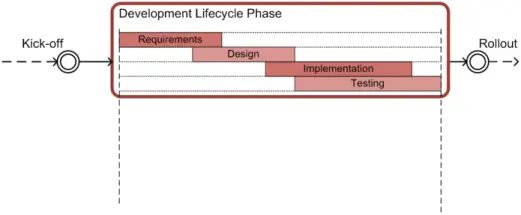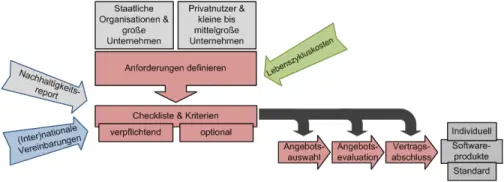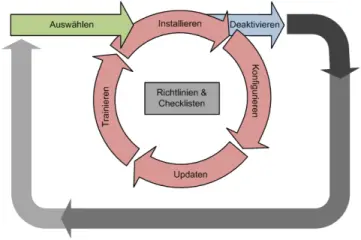Green and sustainable Software Engineering lead to green and sustainable software and tries to follow the principles of a sustainable development by being sustainable in its own processes. Regarding the different stakeholders different procedure models arise:

Green and Sustainable Software Engineering [1] is our example process model for the procedure model part “Develop” of the GREENSOFT reference model. Instead of implementing a complete software development process, it implements only an extension that integrates with arbitrary development processes, e.g. Open Unified Process [2] or Scrum [3].
The enhancements introduced with the process model are: Sustainability Reviews & Previews, Process Assessment, Sustainability Journal, and the Sustainability Retrospective.
In principle, these form a continuous improvement cycle that has the objective to enable stakeholders to recognize impacts that result from “producing” and using/operating a software product.

According to the procurement process, two different roles of purchasers need to be taken into account. On the one hand, there are governmental organizations and large enterprises that use structured tendering procedures in large scale procurement projects, on the other hand, home users as well as small and micro enterprises must not be ignored. Indeed, the potential to pursue sustainability goals of the first group is much higher.

Procedure models for the model part “Administrate” should implement the Plan-Do-Check-Act paradigm, which forms also the basis of common management systems, e.g. quality management (ISO 9000 series), environmental management (ISO 14001), and energy management (ISO 50001/EN 16001). PDCA-like systems can be smoothly integrated with each other.

Looking at the usage of software, the given procedures are mainly ad-hoc. It is not possible to put the procedures into a procedure model, since there are many different usage scenarios and one cannot find a static workflow neither for professional nor for home users.
You are leaving the official website of Trier University of Applied Sciences